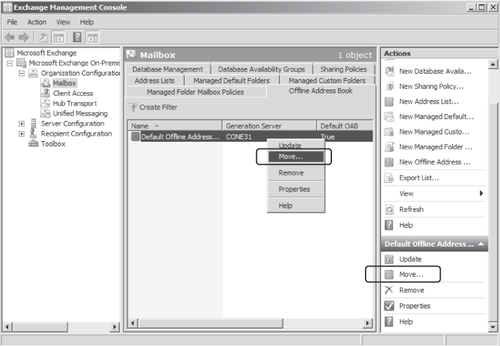6.1.3. Moving Offline Address Books
In Exchange Server 2003 and
earlier, offline address books (OABs) were stored in and distributed
from public folders—system folders in particular—but Exchange Server
2010 (similar to Exchange Server 2007) can distribute OABs by means of a
Web-based distribution method that uses HTTP (or HTTPS) and BITS. This
new distribution method supports more concurrent clients, reduces
bandwidth consumption, and provides more flexibility for distribution
points. It does, however, require that clients be running Outlook 2007
or higher, or that they be using OWA.
Exchange Server 2010,
similar to Exchange Server 2003, can generate the offline address book
in three versions to support various clients, as Table 4 outlines. OAB versions prior to version 4 require you to retain public folder distribution.
Table 4. Offline Address Book Versions
| OAB VERSION | CLIENT SUPPORT |
|---|
| Version 2 | Outlook 98 SP1 or earlier |
| Version 3 | Outlook 98 SP2 or later |
| Version 4 | Outlook 2003 SP2 or later |
When you introduce Exchange
Server 2010 into an existing Exchange Server 2003 organization, the
offline address book remains hosted on Exchange Server 2003, and
Web-based distribution is unavailable. After all mailboxes
have been moved to Exchange Server 2010, Web-based distribution can be
enabled and public folder distribution can be disabled, provided that
clients are using Outlook 2007 or later. If Outlook 2003 or earlier is
still in use after mailboxes have been moved, you will need to maintain
public folder distribution for OABs.
However, to enable Web-based
distribution, you need to move the OAB to an Exchange Server 2010
computer because Exchange Server 2003 only supports public folder
distribution for OABs.
Moving
OABs to Exchange Server 2010 can be accomplished through the EMC or the
EMS. The move task in EMC is accomplished by navigating to the Offline Address Book tab in the Mailbox node beneath the Organization Configuration container, and then clicking Move from the Actions pane as shown in Figure 3 (or by right-clicking the OAB and selecting Move).

To perform the operation via
the EMS, the cmdlet to move all the OABs to an Exchange Server 2010
computer called Seattle-EX10 from an Exchange Server 2003 computer
called Seattle-EX03 is:
Get-OfflineAddressBook -Server Seattle-EX03 | Move-OfflineAddressBook -Server
Seattle-EX10
The GUID of the OAB to be moved is required for the Move-OfflineAddressBook cmdlet. The OABs from the source server are retrieved with Get-OfflineAddressBook, and piping this output to Move-OfflineAddressBook provides the necessary GUIDs to the cmdlet for the move.
To enable Web-based
distribution for the address books after they have been moved to
Exchange Server 2010 you need to either create a new virtual directory
for a distribution point or determine which existing one is to be used
for the purpose. To set the distribution point for the Default Offline
Address List to an Exchange Server 2010 Client Access server named
Seattle-EX10, the following cmdlets will retrieve the OAB virtual
directory on Seattle-EX10, and then configure that virtual directory as
the distribution point for the OAB:
$a=Get-OabVirtualDirectory -Server Seattle-EX10
Set-OfflineAddressBook "Default Offline Address List" -VirtualDirectories $a